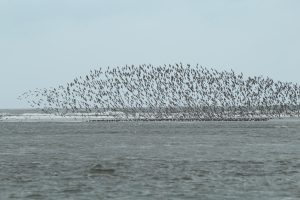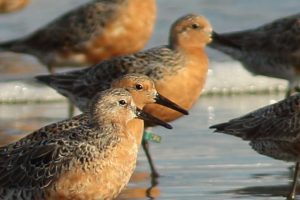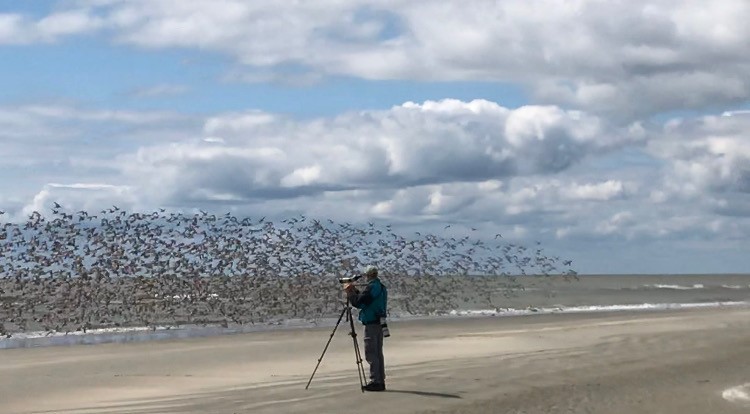As I leave South Carolina behind, so are the Red Knots (Calidris canutus rufa).
Early in the year, when the Red Knots started to show up on Seabrook Island beaches, my friend, Mark Andrews, talked me into helping him get counts of the birds. After several attempts, Mark realized that our numbers could not be very accurate as birds could be anywhere nearby. In an effort to remedy this shortfall, Mark made arrangements for a team of people to create a snapshot survey of the total number of Red Knots on the Kiawah Island and Seabrook Island Beaches. In mid-March we counted about 2,000 Red Knots. On our second effort, at the end of March, the number rose to about 3,200.


The birds all packed together on the beach created problems with assessing numbers. Even combing a photograph proved problematic as the birds squishing so close together made separating individuals impossible. On April 24, I was fortunate enough to snap a photograph of a flock swirling around in the sky coming in for a landing on Kiawah Beach. A small number of birds already sat on the beach. The photograph froze the rest of the flock in the sky cutting off a few on the edge. Using a computer program that allowed me to number each bird, I counted 3,820 birds!

At the same time as the counts, Mark and I started to look for birds wearing small individually unique leg flags. From March 17 on, we made numerous trips out onto the beach and endeavored to sneak up on the birds to read or photograph the flags. Often as the birds actively fed, they tolerated our presence. Often during high tide, the birds rested, either laying down or standing on one leg. Nothing was more frustrating that seeing a number of silver bands glistening in the sun on birds standing on one leg. On other days, no birds were seen anywhere.
Despite these challenges, we were quite successful! Between March 17, 2020 and May 8, 2020, Mark or I sighted 234 flags. Of these, 134 were birds where the code could be clearly read and verified. Of these, 35 were seen more than once; with one bird being seen on seven different occasions.

We submitted all of this information to two different websites, www.bandedbirds.org and the USGS sight, www.pwrc.usgs.gov/BBL/bblretrv/. The USGS site would send a certificate of appreciation for birds they had on record. This certificate showed the date the bird was banded, the location of the state and the head banders name and information. With the Banded Birds site, we could go into a page for mapping sightings and if they had a record, it would include everywhere the bird had been reported and where.
While all this was fun for us, just as we were starting, the corona virus squashed all efforts by the researchers to read flags and to capture birds. We hope our efforts have enabled the science to continue. I hope that up in Delaware and New Jersey where many of the Red Knots are headed there will be birders out there with their cameras and scopes recording the flag on Red Knots they see. It would be so great to know if our South Carolina birds go to the Delaware Bay or if they book on north.


What a wonderful way to spend the winter! I didn’t know that Red Knots were not always red. I’m sure you’ll be making tracks to Cape May to welcome them “home” again.
Technically, I am supposed to self quarantine and by then the birds will be gone.
What a great project, Bob! Thanks for sharing your adventure.
It was fun. Keep posting your positives from nature!
Thank you, Bob. This was a delightful piece on a delightful topic. I hope you do get the data on the number of red knots counted in South Jersey. Wow! Fine work and thanks. Your fan,